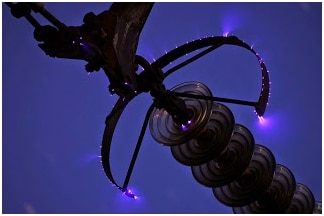
Let Carlos (a consultant for a company developing solar PV system installations) tell you more about this topic.
Partial discharges produce damage that on the long term can end up in electrical failure, which is why it is convenient to establish preventive maintenance in order to consider replacement at proper time before the electrical failure takes place.
Depending on the insulation media, the electrical discharges behave differently, particularly on gases (air and SF6) they can be classified into three main types: External, Internal and Superficial.
External Partial discharges
Occurs when there is a metal tip surrounded by a gas and a voltage is applied to the metal.
This is related to the well-known Corona Effect which is an electrical phenomena caused when the intensity on the conductor surface exceeds the breakdown strength of the surrounding gas and ends up creating the so-called corona sparks (PD) around the conductor (metal).
A typical occasion in which these external partial discharges occur is on the terminals of a transformer, when energized and you try to connect a measurement instrument to the transformer you might see some sparks around the terminal, these are external PD.

Corona Effect – External Partial Discharges | image: cost-plasma-liquids.eu
External partial discharges can be corrected by applying a basic principal of electric field:

Where,
E: Electrical Field
Q: Electrical charge (coulombs)
ξo= Vacuum Permittivity
ξr= Relative Permittivity of the Medium
A= Area
As you can see, if you increase the area of contact, then the electrical field diminishes, if the electrical field diminishes, then the PD diminish as well. So, the solution is to increase the area of contact of the metal to avoid single tips. That is why you can see that in some transmission lines some metal rings at the end of insulators, this is done to reduce the corona effect and sometimes you can still see it.

Corona Effect on a transmission Line | image: electricalengineeringinfo.com
Internal Partial discharges
On the other hand, the internal PD takes place inside the material and they are generally associated with defective manufacturing as they are caused due to cavities or holes inside the equipment that generate small gas breakdowns.
These PD generate an accumulated effect which on the long term could damage the structure of the equipment, affect its electrical or insulation properties and in the worst cases even crack the material.
Internal PD cannot be corrected as they are caused by a bad design in the very structure of the equipment, therefore their detection implies taking preventive measures to substitute the equipment.
Superficial Partial discharges
These PD are produced on the interface between two insulation mediums due to the permittivity change between them (materials with different relative permittivity).
They can be corrected by cleaning the equipment as the contaminants like salts and other dust particles can contribute to formation of an electrical path and to the formation of PD. They are typically seen on insulators.
Conclusion
We have examined the different types of PD that can exist on an electrical equipment.
As stated above, PD are silent but dangerous phenomena that can damage transformers, circuit breakers, generators or motors on the long term and in the best cases, cause performance issues. Some of them can be corrected with preventive measures or technical measurement strategies, others cannot.
It is important to recognize and keep track of the partial discharges within electrical equipment from the moment of the arrival, as this is a progressive phenomenon that is necessary to check within established maintenance periods.
I Prof K.L.Ratnakar appreciate the material given in your news letter, which gives the clear understanding of the prtial discharges. please share your content to my mail id klionelr@gmail.com